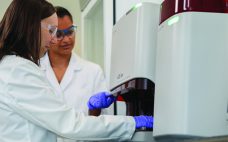The BioProTTTM FlowMeasurement System for the non-invasive measurement of volumetric flows within flexible tubing systems is suitable for both industrial and laboratory applications. It always consists of an evaluation device and a sensor. To ensure the highest possible accuracy, each sensor is adjusted and calibrated according to certain parameters based on the customer’s application. In addition, there are also external factors that impact the accuracy. This document will highlight and explain these factors so that system integrators and operators are…
BPI White Papers
Biosimilar Structural Comparison of Commercially Sourced Reference Standards by MMS Rapidly Detects Subtle but Critical Differences to Correctly Predict Activity for Use in an ELISA Product
It was determined that many of the Bovine Serum Albumin (BSA) reference candidates did not exhibit acceptable activity after inclusion into the final product though all purchased samples shared the same name and identification. The inconsistency in activity causes delays, increases cost of manufacture, and adds an element of variability. Current in-house biophysical techniques fail to correctly identify the inactive candidates prior to product inclusion due to inconclusive results or a lack of sensitivity. Thus a more accurate, reliable analytical…
Evaluate Cell Therapy Product Purity with Aura CL
The CAR-T development workflow is a multi-step process that includes transfection of T cells with a viral vector to express a chimeric antigen and activation/expansion of the CAR-T using a molecule like a Dynabead conjugated to CD3/CD28. Each of these steps is a potential source of contamination that needs to be removed to ensure the purity of the final cell therapy product. Aura CL™ applies multiple detection methods to facilitate the accurate detection and identification of contaminants in a CAR-T…
Media Management: A Critical Consideration Before Intensification
Process intensification (PI) enables faster drug development and increased productivity, flexibility, and quality. But PI can also introduce the challenge of increased media volumes and how to manage them in upstream processes. This whitepaper provides the tools and information needed to consider PI options while evaluating the implications of media management. Follow the media journey from prep to use, exploring potential logistical pitfalls in managing increased media volumes associated with process intensification. Finally, see how the right equipment and platforms…
Octet® Bio-Layer Interferometry Systems: Advancing Development of Coronavirus Vaccine and Therapeutics
Development of vaccines and therapeutics to target outbreaks of infectious diseases such as SARS-CoV-2 requires speed and agility. An essential part of this rapid response are technologies designed to streamline and accelerate workflows while delivering high quality data for informed decision-making. This compendium of applications demonstrates the use of the Octet® label-free platform utilizing bio-layer interferometry (BLI) technology to advance development of coronavirus vaccine and therapeutics. The fluidic-free approach offers important advantages over microfluidics-based technologies such as surface plasmon resonance…
Strategies for Successful Formulation Development of Lipid-Based RNA Delivery and Vaccines
Nucleic acid therapy using RNA and DNA as the active pharmaceutical ingredient (API) has the potential to cause a paradigm shift in the way diseases are addressed. This innovative therapy targets the source of the disease at the genetic level and can be used to modulate the expression of one or more proteins simultaneously – a unique advantage over conventional biologics or small molecules. Given this mode of action, RNA and DNA therapeutics are a powerful means to treat, and…
Shaping the Future of Formulation Development with Melt-based 3D Printing Technologies
Three-dimensional (3D) printing is a powerful technology that has wide-ranging applications, including many in the pharmaceutical industry. Among the approaches that are being explored in the production of pharmaceutical dosage forms powder-based systems which utilize either drop-on-powder or selective laser sintering and liquid-based systems which use drop-on-drop deposition or stereolithography are frequently applied. With liquid-based technology, either UV, laser energy or high temperature is used to induce polymerization and build the 3D structure. The process of 3D printing offers the…
Can CDMOs Provide Leadership in Cell and Gene Therapy?
Cell and gene therapies are poised to usher in a new era of healthcare. As of June 2021, 14 cell and gene therapies have been approved for clinical application in the United States, and over 400 more are in various stages of clinical trials. The hopes of many patients hinge on the success of these various programs, which are designed to deliver a significant advance on existing treatments or even a functional cure. As new cell and gene therapies get…
Establishing Commercial Manufacturing Services for Antibody-Drug Conjugates
The pipeline for antibody–drug conjugates (ADCs) includes hundreds of candidates, with several expected to receive approval in the near future. As more commercial products reach the market, there is an acute need for CDMOs that understand how to execute late-stage studies to support a filing strategy. CDMOs with plans to support commercial-scale ADC manufacturing are setting up processes to handle challenging supply chains and investing in facilities and processes to ensure efficiency, quality and security. In this white paper, we…
Autologous CAR T Cell Manufacturing Using a Semiautomatic, Closed, Modular Workflow
Cell-based chimeric antigen receptor (CAR) T cell therapies have rapidly advanced in recent years, with a variety of targets in clinical research and several FDA approved products already on the market. There has been tremendous effort to make CAR T cells more effective, safe, and persistent when treating patients. On the manufacturing side, however, errors, lot-to-lot variation, and contamination can be associated with open processes and manual handling of CAR T cells. Cell isolation, gene editing, expansion, and cryopreservation are…










